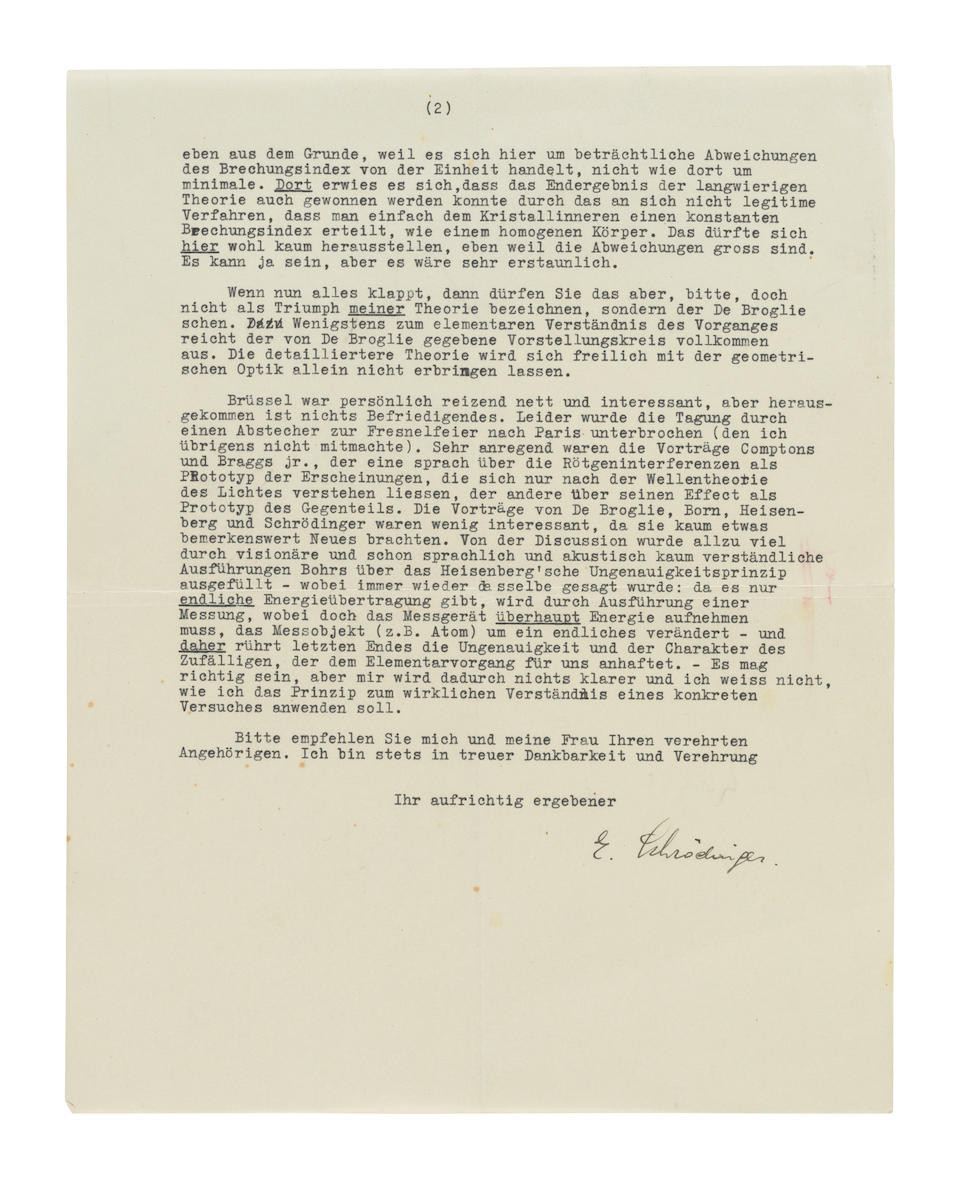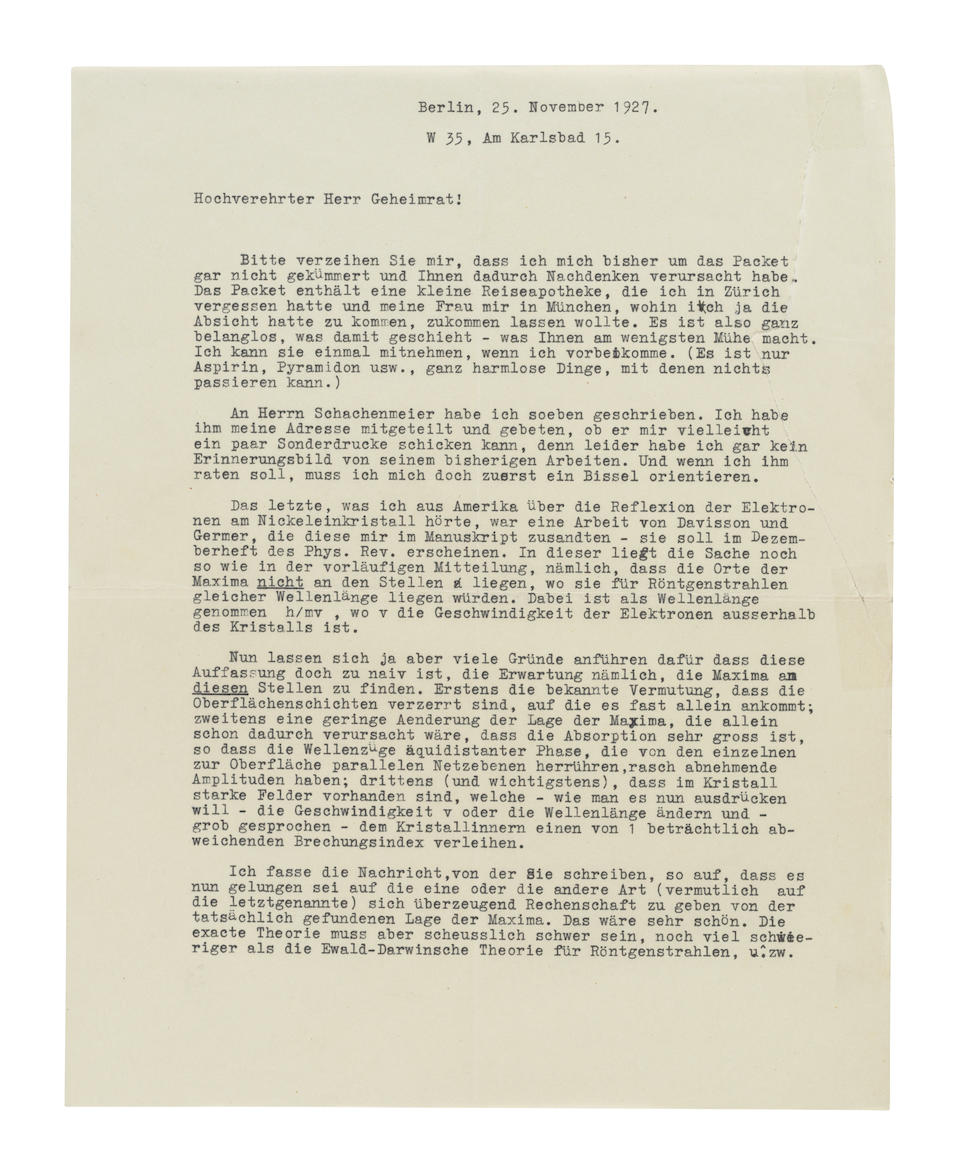22
SCHRODINGER AT THE DAWN OF WAVE MECHANICS. SCHRÖDINGER, ERWIN. 1887-1961. Typed Letter Sig...
SCHRODINGER AT THE DAWN OF WAVE MECHANICS. SCHRÖDINGER, ERWIN. 1887-1961. Typed Letter Signed ('E. Schrödinger') to Wilhelm Wien ('Hochverehrter Herr Geheimrat!)' on the success of the Davisson-Germer experiments and the landmark Solvay Conference in Belgium, 2 pp, with a few corrections in ink, in German, Berlin, November 25, 1927, repaired tear to upper corner of p 1, light stain. Provenance: Wilhelm Wien (noted physicist, 1864-1928); by descent; purchased by the present owner. ON AN EXPERIMENTAL MILESTONE IN THE CREATION OF QUANTUM MECHANICS. The enormously important correspondence between Schrödinger and Wilhelm Wien between 1925 and 1927 traces the history of the development of wave mechanics through the landmark Solvay conference. In this excellent scientific letter, written just after the conference, Schrödinger critiques the Davisson-Germer experiments, a milestone in quantum physics confirming both De Broglie's wave-matter theory and Schrödinger's own wave equations, and provides a first-hand account of Solvay, the 1927 conference which was a vortex of the most important developments in quantum theory. Over the course of five years, the Davisson-Germer experiments proved the wave nature of matter, the basis of Schrödinger's wave mechanics, by bouncing electrons off of nickel crystals and measuring their refraction pattern. Their April 1927 paper had proven the existence of waves in matter, but the calculated wavelengths did not match their observations. Wien had written on November 22: 'From America now comes the news saying that the reflection of electrons from nickel crystals proceeds without doubt according to the laws of x-rays. A great triumph for your theory!' Schrödinger responds that they had sent him the manuscript (which was to be published in December), 'the situation is still the same as in the preliminary communication, namely that the positions of the maxima do not lie at those places where they would for X-rays having the same wavelength ... there are many reasons why this view [the expectation to find the maxima at the same wavelength as in X-rays] is too naive.' He gives three reasons for the deviation, and continues that if indeed they have found an exact theory of electron scattering, then it must be 'terribly difficult, much more difficult that the Ewald-Darwin theory of X-rays, exactly because one is dealing here with considerable deviations of the index of refraction from unity, not like there [the X-ray case] with very small ones ... it would be very surprising.' He concludes that if they have succeeded, 'Please don't call it a triumph of my theory, but of de Broglie's. At least for an elementary understanding of the process, the range of ideas given by de Broglie is completely sufficient.' The Fifth Solvay Conference at Brussels in October 1927 brought together the world's greatest scientists to discuss the newly emergent field of quantum physics. Seventeen of the 29 attendees had or would be awarded the Nobel Prize, including Einstein, De Broglie, Heisenberg, Born, Bohr, Dirac, Pauli and Schrödinger (as well as Marie Curie). However, the competing theories and interpretations in the new science created some discord, prompting Paul Ehrenfest to begin the general discussion of the conference by writing out on the blackboard four lines from the Tower of Babel story. In that vein, Schrödinger begins by applauding the presentations of Arthur Compton and W.H. Bragg, but then notes, 'Too much of the discussion was taken up by Bohr's visionary and linguistically and acoustically hardly understandable statements about Heisenberg's uncertainty principle—whereby the same thing was said again and again ... It may be correct, but it doesn't make anything clearer to me and I don't know how to apply the principle to really understand a concrete experiment.' This letter, one of the last of the important correspondence between Schrödinger and Wien, contains Schrödinger's responses to two of the most momentous advances in quantum physics, Davisson-Germer's confirmation of the wave nature of matter, and the 5th Solvay conference. PUBLISHED: Weyenn, Eine Entdeckung von ganz außerordentlicher Tragweite Schrödingers Briefwechsel zur Wellenmechanik und zum Katzenparadoxon, 2010, no 163, pp 444-447 (with commentary). See Mehra, Erwin Schrödinger and the Rise of Wave Mechanics (The History of the Development of Quantum Mechanics, Volume V, part 2), 1987, pp 866-867. For further information on this lot please visit Bonhams.com For further information about this lot please visit the lot listing
SCHRODINGER AT THE DAWN OF WAVE MECHANICS. SCHRÖDINGER, ERWIN. 1887-1961. Typed Letter Signed ('E. Schrödinger') to Wilhelm Wien ('Hochverehrter Herr Geheimrat!)' on the success of the Davisson-Germer experiments and the landmark Solvay Conference in Belgium, 2 pp, with a few corrections in ink, in German, Berlin, November 25, 1927, repaired tear to upper corner of p 1, light stain. Provenance: Wilhelm Wien (noted physicist, 1864-1928); by descent; purchased by the present owner. ON AN EXPERIMENTAL MILESTONE IN THE CREATION OF QUANTUM MECHANICS. The enormously important correspondence between Schrödinger and Wilhelm Wien between 1925 and 1927 traces the history of the development of wave mechanics through the landmark Solvay conference. In this excellent scientific letter, written just after the conference, Schrödinger critiques the Davisson-Germer experiments, a milestone in quantum physics confirming both De Broglie's wave-matter theory and Schrödinger's own wave equations, and provides a first-hand account of Solvay, the 1927 conference which was a vortex of the most important developments in quantum theory. Over the course of five years, the Davisson-Germer experiments proved the wave nature of matter, the basis of Schrödinger's wave mechanics, by bouncing electrons off of nickel crystals and measuring their refraction pattern. Their April 1927 paper had proven the existence of waves in matter, but the calculated wavelengths did not match their observations. Wien had written on November 22: 'From America now comes the news saying that the reflection of electrons from nickel crystals proceeds without doubt according to the laws of x-rays. A great triumph for your theory!' Schrödinger responds that they had sent him the manuscript (which was to be published in December), 'the situation is still the same as in the preliminary communication, namely that the positions of the maxima do not lie at those places where they would for X-rays having the same wavelength ... there are many reasons why this view [the expectation to find the maxima at the same wavelength as in X-rays] is too naive.' He gives three reasons for the deviation, and continues that if indeed they have found an exact theory of electron scattering, then it must be 'terribly difficult, much more difficult that the Ewald-Darwin theory of X-rays, exactly because one is dealing here with considerable deviations of the index of refraction from unity, not like there [the X-ray case] with very small ones ... it would be very surprising.' He concludes that if they have succeeded, 'Please don't call it a triumph of my theory, but of de Broglie's. At least for an elementary understanding of the process, the range of ideas given by de Broglie is completely sufficient.' The Fifth Solvay Conference at Brussels in October 1927 brought together the world's greatest scientists to discuss the newly emergent field of quantum physics. Seventeen of the 29 attendees had or would be awarded the Nobel Prize, including Einstein, De Broglie, Heisenberg, Born, Bohr, Dirac, Pauli and Schrödinger (as well as Marie Curie). However, the competing theories and interpretations in the new science created some discord, prompting Paul Ehrenfest to begin the general discussion of the conference by writing out on the blackboard four lines from the Tower of Babel story. In that vein, Schrödinger begins by applauding the presentations of Arthur Compton and W.H. Bragg, but then notes, 'Too much of the discussion was taken up by Bohr's visionary and linguistically and acoustically hardly understandable statements about Heisenberg's uncertainty principle—whereby the same thing was said again and again ... It may be correct, but it doesn't make anything clearer to me and I don't know how to apply the principle to really understand a concrete experiment.' This letter, one of the last of the important correspondence between Schrödinger and Wien, contains Schrödinger's responses to two of the most momentous advances in quantum physics, Davisson-Germer's confirmation of the wave nature of matter, and the 5th Solvay conference. PUBLISHED: Weyenn, Eine Entdeckung von ganz außerordentlicher Tragweite Schrödingers Briefwechsel zur Wellenmechanik und zum Katzenparadoxon, 2010, no 163, pp 444-447 (with commentary). See Mehra, Erwin Schrödinger and the Rise of Wave Mechanics (The History of the Development of Quantum Mechanics, Volume V, part 2), 1987, pp 866-867. For further information on this lot please visit Bonhams.com For further information about this lot please visit the lot listing





![[PLATO] EXCEPTIONALLY RARE FIRST PRINTING OF THE TIMAEUS. PLATO. FICINO, MARCELLO, Translator. T...](https://portal-images.azureedge.net/auctions-2024/bonham10938/images/6f319bb4-3506-4464-bec8-b15d011491c8.jpg?w=155&h=155)

![[SHANNON] THE FOUNDING OF INFORMATION THEORY. SHANNON, CLAUDE E. 1916-2001. 'A Mathematical The...](https://portal-images.azureedge.net/auctions-2024/bonham10938/images/68da1450-f46f-4d5a-b3d2-b15d0114919f.jpg?w=155&h=155)

